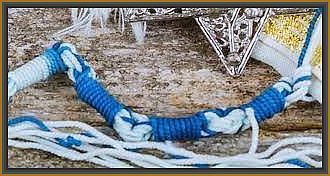Rabbinic Reflections: Issue 164
June 16, 2023 (27 Sivan 5783) Tying the Knot

Dear Friends,
I hope this correspondence finds you doing well and in good cheer. Please join us this Saturday morning at 10:15am in our sanctuary for Shabbat services, which will also be available through our regular Zoom prayer link.
One of the highlights of this week’s Torah portion is the well-known and well-practiced custom of wearing fringes on our four-cornered garments. Like other laws, the Mitzvah of Tzitzit is full of countless customs. From an anthropological viewpoint, the wearing of colorful fringed garments was a sign of royalty or privilege. In honor of the eight strings and five knots which are the design of a correctly wrapped set of fringes, allow me to share some traditions related to our current normative customs!
Tallit Katan vs. Tallit Gadol: Adult Jewish males wear Tzitzit either through donning a large Tallit, called a Tallit Gadol, which is draped over the shoulders, or an undershirt-like small Tallit, called an Arba Kanfot, which is worn under their regular clothes. The blessing for the large Tallit is “who has sanctified us by commanding us to wrap ourselves in Tzitzit,” whereas the blessing for the Tallit Katan is “who has sanctified us by commanding us to through the Mitzvah of Tzitzit. In non-Orthodox communities, males are obligated to wear the Tallit Gadol upon attaining the age of Bar Mitzvah. In Orthodox communities, the Tallit Gadol is worn only after marriage. In non-Orthodox communities, women, as well as men, are encouraged to wear a Tallit and recite the appropriate blessing. T’chelet: In this week’s description of the Tallit there is a reference to a colored fringe on the Tzitzit called T’Chelet. The Rabbis wondered why God commanded the inclusion of one blue thread among the white threads of the Tzitzit. Tractate Menahot of the Babylonian Talmud reports Rabbi Meir asking, “Why is blue different from all other colors?” and then answering, “Because blue resembles the sea, and the sea resembles sky, and the sky resembles God’s Throne of Glory…as it is written: ‘Above the sky over their heads was the semblance of a throne, like sapphire in appearance…'” In other words, Rabbi Meir hypothesizes that the blue thread in Tzitzit is meant to guide its wearers through a chain of associations beginning with immediate visualization of Tzitzit and ending with the expansiveness of God in the universe. For many years there was confusion and debate as to how to obtain the correct mollusk dye to replicate the color of the biblical instruction. Due to that ongoing uncertainty, for many years people only had white Tzitzit. Today, you likely will see many folks wearing a Tallit with a blue tassel called T’Chelet. Shamash: When we see the word Shamash we typically have two associations: the “helper” candle of the Hannukiah which is used to light the other candles on the nights of Hannukah OR the term was used in reference to the “helper” elderly gentleman in the synagogue. This Shamash was tasked with numerous shul tasks including turning on the Yarzheit lamps, unlocking the door before the beginning of the minyan, welcoming the parishioners to Temple, and pouring the L’chayim after mourners’ Kaddish. However, the original Shamash, or helper, is the longest of the four folded strings (often colored in blue) which wraps around the other strings in a halachically described fashion. This results in the intricate patterns that you will see on each of the four Tzitzit that are on your Tallit. Yasher Koach to the Shamash! V’Asu Lahem Tzitzit: The biblical verse (Bem. 15:38) states, “and instruct them to make for themselves”. For this reason, many people believe that they have not properly fulfilled the commandment unless one firstly, actually avoids the trip to Judaica House, and secondly, ties/winds the strings by oneself. I fondly recall in my pre-Bar Mitzvah year, constructing my own full Tallit as an “activity” in Hebrew school. Whereas this was no easy task (or tassel!), it was certainly memorable. Believe it or not, I have that Tallit from decades ago and to this day where it on cold winter days (it is a Canadian Tallis after all). Ureetem Oto: In the next verse of this week’s Torah reading (Bem.15:39), the text states “and you shall see them.” This stipulation is the basis for two current practices. Firstly, Tzitzit are only obligatory during the daylight hours as they cannot be seen at night. Secondly, Tzitzit are often displayed outside the garment so they are visible for all to see. Ideally, when a Jewish person sees the Tzitzit, they are reminded of their daily obligations to fulfill the Mitzvot of Hashem.
Ultimately, I believe there is a profound purpose in wearing Tzitzit. The act of getting out of bed in the morning to don the Tallit Katan orients our day through words of immediate blessing. The act of seeing Tzitzit throughout our workday reminds us of the pervasive potential of holiness in each of our daily encounters. And finally, as I fold my Tallit over a chair at the end of my day, I am reminded that Hashem has watched over me and draped me in his divine protection of love and guardianship throughout my waking hours.
As we enter the tranquility of Shabbat, I pray that meditating upon the Mitzvah above will encourage us to “tie the knot” with as many Mitzvoth as possible in the week to come. May we continue to explore all the beauty of our Judaism inherently available to us as members of a treasured people and kingdom of priests.
Shabbat Shalom,
Rabbi Eric L. Wasser, EdD, Hon.DM
Tel: 201-562-5277
elw613@gmail.com
WANT MORE??? Click HERE!!!
|

